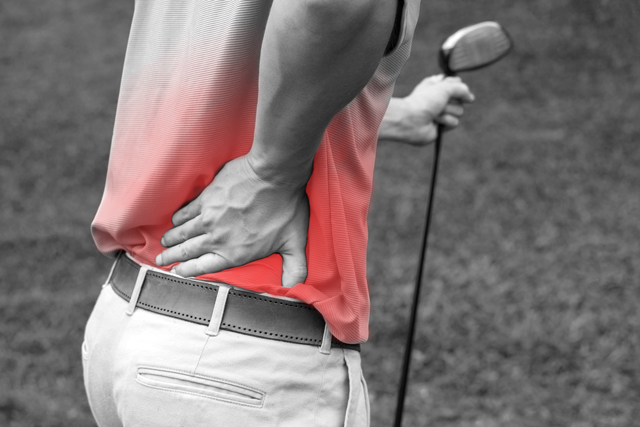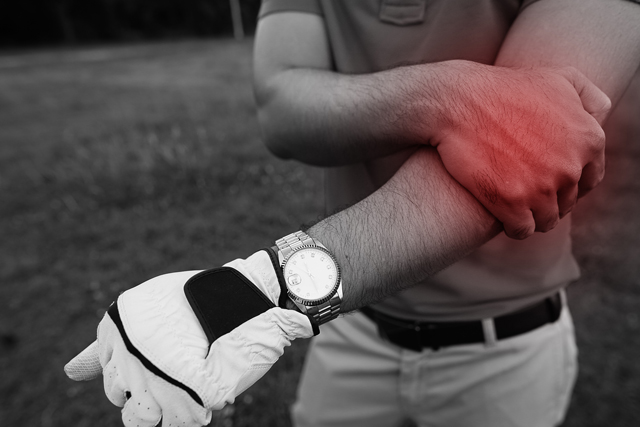We see it all the time. People in Phoenix love to golf and get out on the green as often as possible. Unfortunately, we also see a lot of injuries. Golfing might not be a grueling, contact sport, but it can still bring about aches and pains during your game.
If you are an avid player, these are most likely the golfing injuries keeping you off the green with ways to overcome them.

1. Back Pain
Back pain affects millions of American across the United States and the same holds true for golfers as well. The thing is, when you are determined to fix your golf swing and spend a ton of time practicing, you are also hunching over your golf club for long periods of time. Combine that with the constant rotation to master that beautiful swing and you could be in serious back pain trouble.
It seems as though lower back pain is the most troublesome and it can be a real hazard to your tee time. You also can’t discount the pain that might also shoot or stab through your shoulder blades. It’s all back pain and it’s all a pain to your golf game.
Your first approach to treatment might include the following:
- Rest
- Alternating between hot and cold packs
- Anti-inflammatory pain medications, such as ibuprofen
- Deep tissue massage
- Chiropractic adjustment
If you are finding no relief with these approaches, it might be time to step it up a notch and visit a pain specialist. You might need additional treatments such as steroid injections or possibly even surgery.
2. Rotator Cuff Injury
Located within your shoulder are four stabilizing muscles that make up your rotator cuff. If you golf often, you might have felt these muscles swell and pinch in the area between the arm and shoulder bones. Additionally, another tendon or muscle can tear in this area, causing great discomfort.
Prevention for most rotator cuff injuries includes practicing in correct form. What also makes a difference for your rotator cuff is routinely exercising, including strength training and stretching of the muscles within your shoulders, back and abs.
If you are already experiencing discomfort, it is best to stop your golf game and rest. You should be icing the problem areas. If your pain begins to decrease, then you should follow up with strength training exercises to begin muscle building.

3. Tennis Elbow and Golf Elbow
Oddly enough, more golfers suffer from tennis elbow than the quintessential golf elbow. Tennis elbow refers to tendonitis located specifically in the tendon of your outer elbow. Golf elbow is tendonitis of the tendon on the inside of your elbow.
Participating in either sport requires you to practice good form for either swing to prevent this injury. It is important to rotate your practice regimen routinely, and getting adequate rest for your arms.
The real way to reduce the inflammation in your elbow is to just plain rest. It might be tough to put the clubs down for awhile, but it will help you heal faster.
4. Knee Pain
From your back all the way down to your knees is possible to experience pain at some degree with your golf swing. During the rotation of your swing, you end up putting a lot of stress and strain on the weaker knee. This strain can vary in severity and intensity. When it comes to your knees, you will definitely notice the changes progressively worsen as you age.
It is always recommended to visit with your doctor when experiencing knee pain. To prevent further damage, it is important to have a good stretching routine that hits up your calves, knees, hamstrings, thighs and your core muscles. Be sure to wear quality shoes with good arch support.
The key is to not ignore your knee pain. You want your doctor to diagnose the exact problem and determine the proper course of treatment. You definitely do not want to damage them further or affect your ability to play at all.
5. Tendinitis in the Wrist
Wrist pain can be excruciating to play a game of golf with. Similar to tennis elbow, tendinitis in your wrist occurs when the tendons become overly fatigued and inflamed. When your wrists are in pain, you tend to hold your club incorrectly and overcompensating in other areas.
The key here is to not forget to condition and strengthen your wrists during the off season or in the gym in general. There are many simple stretches and strength training exercises you can do for the tendons in your wrist.
Final Thoughts
It is a huge bummer when an injury keeps you off the green. During your next golf game, pay close attention to any nagging pains you might have. Work on stretching and strengthening those areas whenever possible. If the pain is keeping you from grabbing your clubs, then seek medical attention to get a diagnosis and a proper treatment plan.
Comments are closed.
